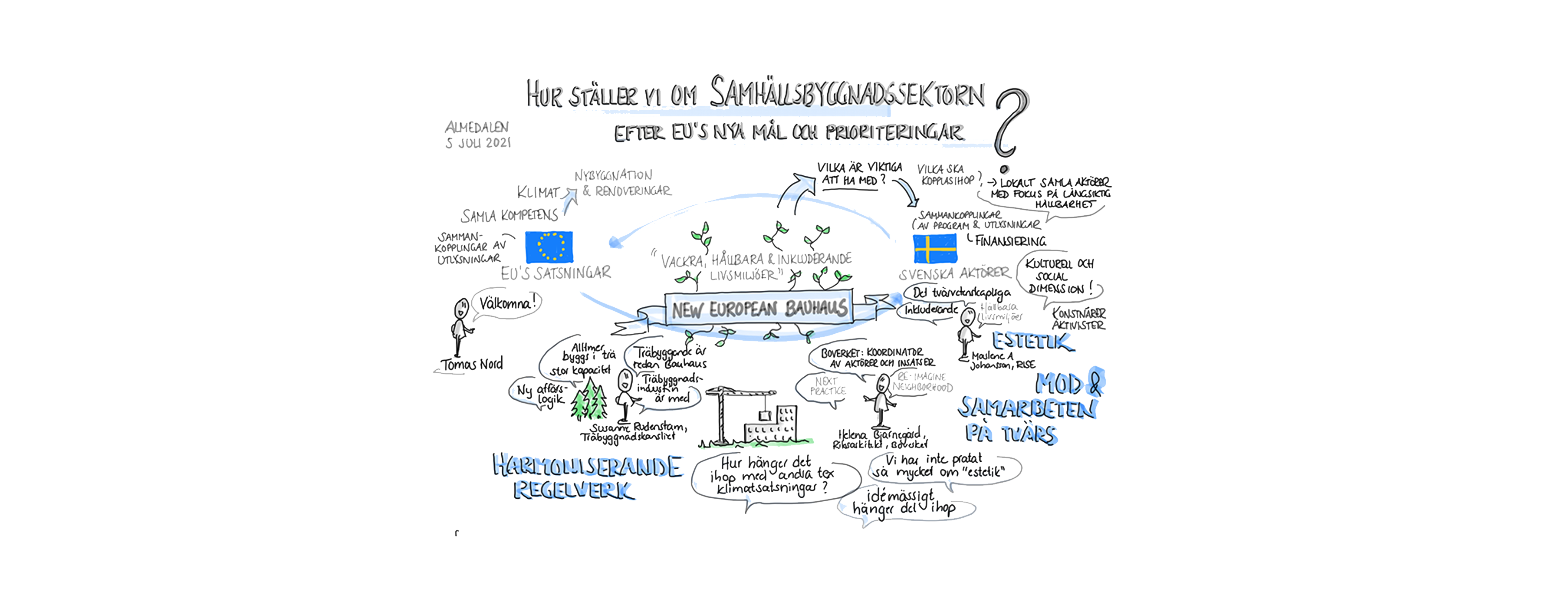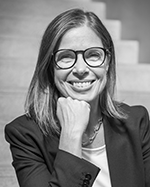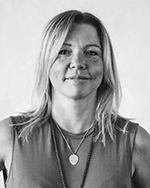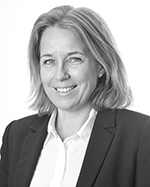
THIS IS HOW SWEDEN CAN CONTRIBUTE TO THE CREATIVE CHALLENGES IN NEW EUROPEAN BAUHAUS
Beautiful, sustainable and inclusive are the key words or phrases within the New European Bauhaus (NEB), – EU’s new, creative and inspiring initiative with a focus on the future housing and living environments in Europe. But how can Sweden and its actors really make an impression and contribute with creative proposals and experiences in in the design of the future society?
Tomas Nord, process manager at Smart Housing Småland, gave an overall view of the unique and future-oriented challenges that New European Bauhaus entails. The participants in the seminar under the heading “How do we position the development of society according to the EU’s new goals and priorities?” received answers to questions about the process. Deeper knowledge around the phrases beautiful, inclusive and sustainable was also discussed. One result is that a lot of competence and activities actually exist in Sweden; we are well prepared and we have good chances to contribute to and benefit from NEB. RISE soon became an official partner of NEB and it was recently announced that the innovation environment Smart Housing Småland has also become a partner in NEB.
The connection to ”European Green Deal”
The presentations that took place were very inspiring. Helena Bjarnegård, National Architect Boverket, Marlene A Johansson, RISE and Susanne Rudenstam, CEO of the Swedish Wood Construction Office.
 Helena Bjarnegård, National Board of Housing, Building and Planning, emphasized the connection between the New European Bauhaus and the EU’s “Green Deal”, i.e. the transition to a sustainable development of the society in Europe, but NEB also has a bearing on the serious corona pandemic, as a positive metaphor and future vision for how we should shape housing and living environments in Europe. The National Board of Housing, Building and Planning has also been commissioned by the government to coordinate creative initiatives that are made in Sweden – nationally, regionally and locally.
Helena Bjarnegård, National Board of Housing, Building and Planning, emphasized the connection between the New European Bauhaus and the EU’s “Green Deal”, i.e. the transition to a sustainable development of the society in Europe, but NEB also has a bearing on the serious corona pandemic, as a positive metaphor and future vision for how we should shape housing and living environments in Europe. The National Board of Housing, Building and Planning has also been commissioned by the government to coordinate creative initiatives that are made in Sweden – nationally, regionally and locally.
– It is incredibly inspiring with New European Bauhaus, and I see connections to many other initiatives, such as our work with designed living environment and Sustainable Cities, but also a whole range of other exciting activities around Sweden. It’s not about controlling but working together with creative ideas, says Helena Bjarnegård.
Regional and local initiatives
 Marlene A Johansson, researcher and one of the persons responsible at RISE for the NEB initiative, described how RISE works and coordinates ongoing NEB initiatives. As a national research institute, RISE has a key role in various contributions and collaborations from Sweden in the NEB process. The RISE innovation platforms for cities and municipalities of the future and the focus on small and medium-sized companies make it possible for more people to get an opportunity to participate, which also creates conditions for regions and local initiatives. As an example of ongoing development, Marlene A Johansson mentioned the green “new industrialization” that is taking place in the northern part of Sweden, where companies and jobs will be created in the coming years.
Marlene A Johansson, researcher and one of the persons responsible at RISE for the NEB initiative, described how RISE works and coordinates ongoing NEB initiatives. As a national research institute, RISE has a key role in various contributions and collaborations from Sweden in the NEB process. The RISE innovation platforms for cities and municipalities of the future and the focus on small and medium-sized companies make it possible for more people to get an opportunity to participate, which also creates conditions for regions and local initiatives. As an example of ongoing development, Marlene A Johansson mentioned the green “new industrialization” that is taking place in the northern part of Sweden, where companies and jobs will be created in the coming years.
– It is by creating collaborations and channels for national, as well as regional initiatives for sustainable, inclusive and beautiful communities, places and development projects and connecting them with the New European Bauhaus we can achieve results and make an impression from Sweden, says Marlene A Johansson.
Susanne Rudenstam, CEO of Wood Construction Office, spoke about the exceptionally rapid development in wood construction that is taking place in Sweden. With the unique Swedish and Nordic forest resource as a base, it can make a significant contribution to sustainable and climate-efficient construction throughout Europe.
Wood construction technology is equal to positive system changes as a result in all areas – not only technically – it can also make a strong impression in social sustainability and a better balance between expansive urban environments and sparsely populated parts under the motto “The country builds the city”. An important aspect and a possible development that may well cover the whole of Europe – with inspiration from Sweden.
Preschool Hoppet – a mental image
A new construction process based on industrial ideas is an important driving force behind the positive development in wood construction, which also provides added value in the form of a better working environment, safer working conditions and increased gender equality.
 – It is important to point out that wood construction technology is a new construction process, where elements along the entire value chain contribute to better resource management, inclusion, changed roles and of course and not least; climate smart housing and living environments, says Susanne Rudenstam.
– It is important to point out that wood construction technology is a new construction process, where elements along the entire value chain contribute to better resource management, inclusion, changed roles and of course and not least; climate smart housing and living environments, says Susanne Rudenstam.
In this context, Susanne showed two current flagships, one of which is the 20 storey high Sara Kulturhus in Skellefteå, which not only pushes the limits for modern wooden building technology, but also takes bold and innovative approaches in terms of design, functionality and community.
The second project – the preschool Hoppet in Gothenburg, is according to Susanne “Sweden’s most important construction project”, which will be the first in Sweden to – almost – achieve zero level carbon dioxide emissions. Without compromising on high demands when it comes to all other aspects of sustainability.
Preschool Hoppet may well constitute an image, a practical example for the key phrases within the NEB initiative; beautiful, sustainable and inclusive. Susanne emphasized that it is possible to work with new projects, when developing the society, that gradually consume a little less of the resources of the planet. Without missing what is beautiful and inclusive.
Listen to the webinar “How do we position the public construction sector according to the EU’s new goals and priorities? here
If you missed one or more of our seven webinars, it is possible to watch them here.
If you missed one or more of our seven webinars, it is possible to watch them (Swedish) here

